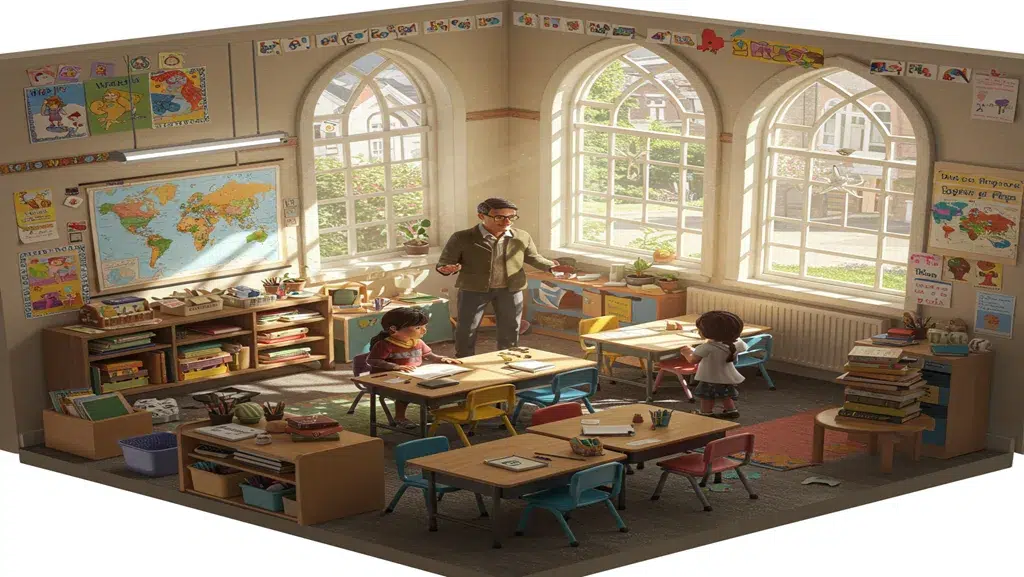Education is evolving rapidly, and so are the spaces where learning happens. One of the most exciting developments in this field is the concept of Classroom 15x—a revolutionary approach to designing and utilizing learning environments for better engagement, flexibility, and innovation.
What Is Classroom 15x?
Classroom 15x refers to a next-generation learning space designed to enhance collaboration, adaptability, and technological integration. Unlike traditional classrooms with fixed desks and rigid layouts, Classroom 15x embraces flexibility, allowing educators to reconfigure the space based on different teaching styles and student needs.
The name “15x” suggests a multiplier effect—where the learning environment amplifies engagement, creativity, and productivity by 15 times compared to conventional setups. These classrooms often feature:
- Modular furniture (movable desks, chairs, and whiteboards)
- Advanced technology (interactive screens, VR tools, and AI-assisted learning)
- Collaborative zones (group workspaces, discussion pods, and quiet study areas)
- Sustainable design (natural lighting, energy-efficient materials, and green spaces)
This innovative approach is being adopted in schools, universities, and corporate training centers worldwide, transforming how people learn and interact.
Key Features of Classroom 15x
To understand why Classroom 15x is gaining popularity, let’s break down its most impactful features:
1. Flexible and Adaptive Layouts
- Unlike traditional classrooms, Classroom 15x allows quick reconfiguration for lectures, group work, or hands-on activities.
- Teachers can switch between different setups (theater-style, circular, or workshop mode) in minutes.
2. Technology-Enhanced Learning
- Smartboards, tablets, and augmented reality (AR) tools make lessons more interactive.
- Cloud-based platforms enable seamless sharing of resources and real-time collaboration.
3. Student-Centered Design
- The layout encourages active participation rather than passive listening.
- Comfortable seating and ergonomic designs improve focus and reduce fatigue.
4. Sustainability and Well-being
- Natural lighting, indoor plants, and air-purifying materials create a healthier environment.
- Energy-saving features like motion-sensor lights reduce the classroom’s carbon footprint.
Benefits of Classroom 15x
Why should schools and institutions consider adopting Classroom 15x? Here are some compelling advantages:
1. Boosts Engagement and Participation
- Interactive setups encourage students to collaborate, ask questions, and take ownership of their learning.
- Gamification and digital tools make lessons more dynamic.
2. Supports Diverse Learning Styles
- Visual, auditory, and kinesthetic learners all benefit from adaptable spaces.
- Quiet zones help introverted students, while group areas support social learners.
3. Prepares Students for the Future
- Exposure to cutting-edge technology builds digital literacy.
- Collaborative workspaces mimic modern workplaces, teaching teamwork and adaptability.
4. Improves Teacher Efficiency
- Educators can easily switch between teaching modes without wasting time rearranging furniture.
- Digital tools streamline grading, feedback, and lesson planning.
How Classroom 15x Is Changing Education
Several forward-thinking institutions have already implemented Classroom 15x with impressive results:
Case Study: Stanford University’s Active Learning Classrooms
- Stanford redesigned classrooms with round tables, multiple screens, and writable walls.
- Studies showed a 20% increase in student performance due to better engagement.
Example: Finland’s Phenomenon-Based Learning Spaces
- Finnish schools use flexible classrooms to support interdisciplinary learning.
- Students work on real-world projects in collaborative, tech-enabled spaces.
Corporate Training with Classroom 15x
- Companies like Google and Microsoft use similar setups for employee training.
- Interactive workshops and VR simulations enhance skill development.
Challenges and Considerations
While Classroom 15x offers many benefits, there are challenges to consider:
1. High Initial Costs
- Advanced technology and modular furniture require significant investment.
- Schools may need grants or phased implementation plans.
2. Teacher Training
- Educators must adapt to new teaching methods and tech tools.
- Professional development programs are essential for smooth transitions.
3. Space Limitations
- Not all schools have large areas for flexible layouts.
- Creative solutions (like foldable furniture) can help maximize smaller rooms.
Future Trends in Classroom 15x
As education continues to evolve, Classroom 15x will likely incorporate:
- AI-Powered Personalization – Adaptive learning software tailoring lessons to individual students.
- Hybrid Learning Spaces – Combining physical and virtual classrooms seamlessly.
- Biophilic Design – More nature-inspired elements to reduce stress and improve focus.
Final Thoughts
Classroom 15x represents a bold step toward the future of education—one where learning spaces are as dynamic and innovative as the students who use them. By embracing flexibility, technology, and student-centered design, schools can create environments that inspire creativity, collaboration, and lifelong learning.
Frequently Asked Questions (FAQs)
1. How is Classroom 15x different from a traditional classroom?
- Traditional classrooms have fixed desks and teacher-centered layouts, while Classroom 15 x is flexible, tech-integrated, and student-focused, promoting collaboration and active learning.
2. Can small schools afford Classroom 15 x?
- Yes! While high-tech versions can be expensive, even simple changes like movable furniture and better lighting can create a Classroom 15 x effect on a budget.
3. Does Classroom 15 x improve academic performance?
- Research shows that flexible, interactive classrooms increase engagement, participation, and retention, leading to better learning outcomes.
Read Also –
